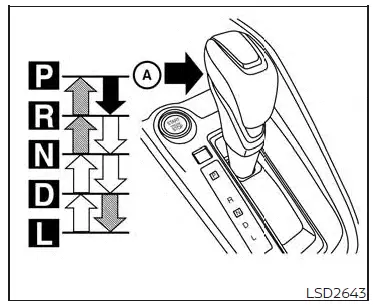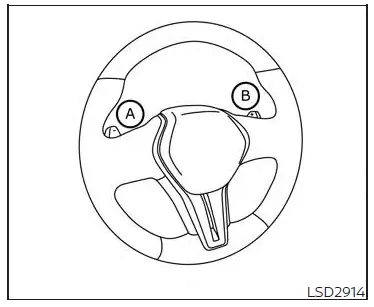Nissan Altima (L34) 2019-2025 Owners Manual: Starting the vehicle
1. After starting the engine, fully depress the foot brake pedal before moving the shift lever out of the P (Park) position. The Continuously Variable Transmission is designed so the foot brake pedal MUST be depressed before shifting from P (Park) to any drive position while the ignition switch is in the ON position. The shift lever cannot be moved out of P (Park) and into any of the other gear positions if the ignition switch is placed in the LOCK position.
2. A screen is displayed for a period of time that indicates the status of the driving aid functions (if so equipped).
- AEB with Pedestrian Detection, LDW, and BSW are enabled when the specified driving aid is shaded.
- I-LI is enabled when the driving aid is solid.
- Use the 1
 or 2
or 2
 button to
navigate the settings screen. For additional
information, see "How to use
the vehicle information display".
button to
navigate the settings screen. For additional
information, see "How to use
the vehicle information display".
3. Keep the foot brake pedal depressed and move the shift lever to a driving position.
4. Release the foot brake, then gradually start the vehicle in motion.
5. Stop the vehicle completely before moving the shift lever to the P (Park) position.
WARNING
- Do not depress the accelerator pedal
while shifting from P (Park) or N (Neutral)
to R (Reverse), D (Drive), L (Low) or
manual shift mode (if so equipped).
Always depress the brake pedal until shifting is completed. Failure to do so could cause you to lose control and have an accident.
- Cold engine idle speed is high, so use caution when shifting into a forward or reverse gear before the engine has warmed up.
- Do not downshift abruptly on slippery roads. This may cause a loss of control.
- Never shift to either the P (Park) or R (Reverse) position while the vehicle is moving forward and P (Park) or D (Drive) position while the vehicle is reversing. This could cause an accident or damage the transmission.
CAUTION
- Except in an emergency, do not shift
to the N (Neutral) position while driving.
Coasting with the transmission in the N (Neutral) position may cause serious damage to the transmission.
- To avoid possible damage to your vehicle, when stopping the vehicle on an uphill grade, do not hold the vehicle by depressing the accelerator pedal. The foot brake should be used for this purpose.

Shifting
To move the shift lever:
 Press the button A while
depressing
the brake pedal
Press the button A while
depressing
the brake pedal
 Press the button A to shift
Press the button A to shift
 Shift without pressing the
button A
Shift without pressing the
button A
After starting the engine, fully depress the brake pedal and move the shift lever from P (Park) to any of the desired shift positions.
WARNING
Apply the parking brake if the shift lever is in any position while the engine is not running. Failure to do so could cause the vehicle to move unexpectedly or roll away and result in serious personal injury or property damage.
P (Park)
CAUTION
To prevent transmission damage, use the P (Park) or R (Reverse) position only when the vehicle is completely stopped.
Use the P (Park) shift lever position when the vehicle is parked or when starting the engine. Make sure the vehicle is completely stopped. The brake pedal should be depressed to move the shift lever from N (Neutral) or any drive position to P (Park).
Apply the parking brake. When parking on a hill, apply the parking brake first, then move the shift lever into the P (Park) position.
R (Reverse)
CAUTION
To prevent transmission damage, use the P (Park) or R (Reverse) position only when the vehicle is completely stopped.
Use the R (Reverse) position to back up.
Make sure the vehicle is completely stopped before selecting the R (Reverse) position. The brake pedal must be depressed to move the shift lever from P (Park), N (Neutral) or any drive position to R (Reverse).
N (Neutral)
Neither forward nor reverse gear is engaged.
The engine can be started in this position. You may shift to N (Neutral) and restart a stalled engine while the vehicle is moving.
D (Drive)
Use this position for all normal forward driving.
L (Low)
Use this position for engine braking on steep downhill gradients/climbing steep slopes and whenever approaching sharp bends. Do not use the L (Low) position in any other circumstances.


 Continuously Variable Transmission
(CVT)
Continuously Variable Transmission
(CVT) Manual shift mode (if so
equipped)
Manual shift mode (if so
equipped)